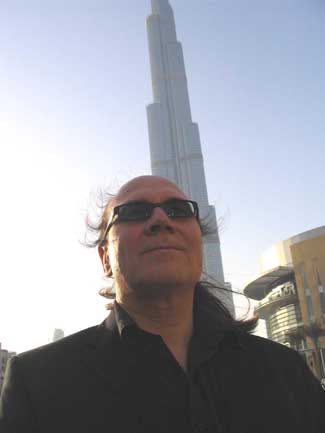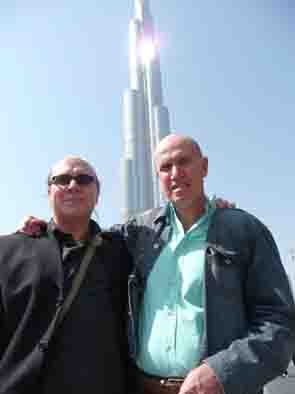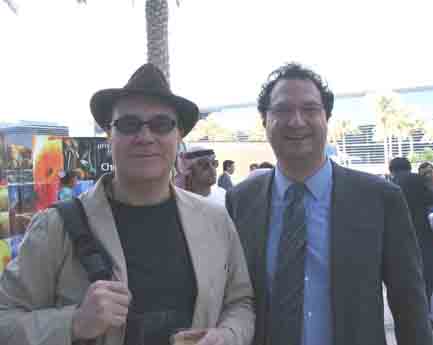![]()
![]()

Andrew
Collins in front of the world's tallest building (pic credit: Carlo
Dorofatti,
2010).
Andrew
Collins Reports on
2010 ICAS Conference in Dubai
On
February 12/13, 2010, I attended the ICAS conference held in the Zayed University,
Dubai, United Arab Emirates. I was there to deliver a lecture entitled "Finding
Eden: Gobekli Tepe and the Origins of Civilization". It concerned the discovery
in 1994 of the world's oldest stone temple complex at a site called Gobekli Tepe
in southeast Turkey, and the continuing work there of Professor Klaus Schmidt
of the German Archaeological Institute (DAI). The lecture also featured the rediscovery
of Giza's cave underworld, citing its possible African influence through the presence
of serpentine rock simulacrum and red ochre on the walls.
Robert Bauval, who presented two lectures at the event, confirmed to me that images in red ochre have been found in caves and rock shelters in the southwest corner of Egypt, close to the border with Sudan and Chad. He also showed me depictions of long-headed bushmen among the rock art, with long serpentine heads similar to the serpent-head simulacrum in the Giza caves. Clearly, if I could establish the African influence of the caves at Giza, this would support Bauval's theories concerning a black African connection to the origins of the pharaonic race, the theme of his upcoming book Black Genesis.

Andrew
Collins and Robert Bauval in Dubai
(pic credit: Andrew Collins, 2010)
Graham Hancock presented a hybrid lecture, featuring material from Fingerprints of the Gods, Underworld and Heaven's Mirror. He ended his talk with a recital of a remarkable Prophecy of Hermes drawn from the wonderful corpus of hermetic literature written around 2,000 years ago. It told of the loss of the great universal wisdom as mankind strays from the true path of righteousness and understanding, and how God will rectify this with a universal rebirth of humanity. I am not a great admirer of prose or poetry, but this was an extraordinary reading, and one which I later found contained in a pocket book entitled The Hermetica: The Lost Wisdom of the Pharaohs by Timothy Freke and Peter Gandy. I highly recommend it not just for the Prophecy of Hermes, but also for the rest of its extraordinary contents.
Graham has his first novel out in April entitled Entangled. It is about contact between two individuals at opposite ends of human history - one today and the other some 24,000 years ago in the Stone Age. I sense it will be a modern day Carlos Castanada-like scenerio, with some quantum entanglement and time travelling thrown in for good measure, and lots of battles and adventures. Random House is the publisher in the UK and Commonwealth, with Disinformation the publisher in the United States. Apparently, it is the first of two books in a series. The project sounds great, and is something I shall bring you more on in the coming months, including the link to a video with Graham reading passages from the books.
Boston geologist Dr Robert Schoch was also there to make a presentation, which featured not only his well-known work on Giza's Sphinx monument, but also his recent investigations into the history and evolution of Easter Island's moa-building culture. He seems excited by the cave discoveries at Giza, and showed an interest in supporting future investigations.
Other speakers included Christopher Knight, the co-author of The Hiram Key and the recently published Before the Pyramids. The book, co-written with Alan Butler, is published by my old publishers Watkins/Duncan-Baird. Chris and Alan's work is quite extraordinary and demonstrates the relationship between the design and construction of European megalithic monuments and a standard measure, the so-called megalithic yard of Professor Alexander Thom, the grandaddy of archaeoastronomy. This Chris and Alan have determined was derived from fractions of time created as a measurement by noting the length of a plum bob as it swings at one cycle a second. Their work is impressive, and worthy of consideration.
John Major Jenkins gave his latest take on the Maya prophecies of 2012 in the wake of the incredible amount of publicity the subject received during the screening of Roland Emmerich film of the same name, released at the same time as John's recent book The 2012 Story.
Over breakfast the day after his lecture, I simply had to ask John what he would be doing come 2013, especially as his last three books have all been about the Maya prophecies of 2012. His answer should remain private, but suffice it to say that it won't involve either the Maya or future prophecies!
Michael
Cremo, co-author of Forbidden
Archaeology, delivered his ever impressive round of forbidden archaeological
discoveries from around the world - artefacts and human remains that have been
unearthed in geological strata beyond that of human beings at the stage of development
accepted for such trinkets of time. I was fascinated to hear about some research
he has been carrying out here in the UK.
In 1881 H. Stopes, a fellow of
the Geological Society, delivered a lecture regarding the discovery of a sea-shell
on which was found carved a smiley face. This was located in red crag, a rock
strata exposed within the cliffs at Walton-on-the-Naze, in my former home county
of Essex. The context seemed indisputable. The problem is that the red crag layer
dates to a geological age known as the Pliocene, which ended some two million
years. So to accept the authenticity of the artefact, it would mean accepting
that hominids, i.e. proto-humans, with a basic level of artistic expression existed
in Britain (then part of a much greater landmass) during this distant epoch, something
that palaentologists are unable to do.
Adding to the mystery was the discovery in 1855 of a human jaw in a red crag pit, dug in 1855 at Foxhall, near Ipswich in Suffolk, in order to extract a substance called cuprolite, used in animal feed. Anatomically, the jaw is very close to the features of homo sapien sapiens, i.e. modern human beings, who first emerged in central Africa around 200,000 years ago. Beyond even this was the discovery during the same century, at five exposed areas of red crag, including the pits at Foxhall, of a large number of worked flints, which would also need to have been fashioned some two million years ago.
Now, you would think that this would be enough to establish the existence of early humans during this distant geological epoch. Yet conventional thinking has the earliest hominids in this part of the world as appearing no earlier than 700,000 years ago. This is despite the discovery of hominid activity in Ethiopia dating back 3.7 million years, and the finding in 2001 that the earliest hominids migrated from Africa to the Eurasian continent sometime between 2 and 1.7 million years ago.
The Foxhall flints are not accepted as genuine human artefacts by the mainstream palaentological community, while the Foxhall jaw and Walton carved shell are dismissed either as later intrusions into the red crag, or straight forward hoaxes. Michael Cremo is out to prove this wrong, and is searching for the whereabouts of both the jaw and the shell in the hope that they might finally be taken seriously by academia. There is a problem, however. Nobody knows where the artefacts are today, so Michael is currently following up various leads, which I have vowed to help him with in the future.
Also presenting lectures were Italian writer-researcher Carlo Dorofatti, the author of several e-books, who spoke on Alantis and the nature of reality in the context of the discovery of ancient mysteries; Armando Mei, co-author of Giza: le Piramidi Satellite ed il Codice Segreto, who argued for alignments at Giza corresponding to the age of the gods in the Canon of Turin; Ahmad Osman, who talked about the origins of agriculture in the Near East, and architect Jean-Paul Bauval, Robert's brother, who spoke about the construction and situation of the Great Pyramid on the plateau at Giza.
There was also a wonderful display of modern art styled on the ancient moa culture of Easter Island, or Rapa Nui, as it is known to the artist, Christian Tuki, who actually came to the conference with a delegation from the island. He exhibited dozens of paintings and pieces of sculpture that might well have been manufactured by the original moa building race. A great sight to see, and well worth checking out.One day I would love to go to Easter Island. I fell in love with the place as a kid after watching the TV documentary series on Thor Heyerdahl's 1947 Kon Tiki expedition, which proved that a plain sailing vessel could have journeyed from South America to the Polynesian Islands in ancient times.

Andrew
Collins and Carlo Dorofatti in Dubai
(pic credit: Carlo Dorofatti, 2010).
Dubai is a quite extraordinary place. Very futuristic, clean, multi-cultural and multi-religious, creating an environment where everyone seems to live in complete harmony. It is inspiring to see, and perhaps reflects a vision of the rest of the world in fifty to one hundred years time. As such, Dubai is building for the future, for which reason it is set to become a global new age centre, with events like this making real that greater vision. I look forward to returning there some time soon.
I thank the organizers of the ICAS event for their hospitality. I also thank the sponsors for their generosity. These include the Pro-Chile trade organization for Dubai, coordinated by the Ambassador of Chile, Jean-Paul Turad K, and his wife Valentina. For more on this event, and further pictures, go to my Facebook page by clicking here.
![]()
